Disclosure: Some of the links in this post are affiliate links. This means if you click on the link and purchase an item, Sees Food, Will Travel will earn a commission at no extra cost to you. See terms and conditions for details.
Ginataang bilo bilo translates to coconut soup with glutinous rice balls. When it comes to Filipino desserts, ginataang bilo bilo is a timeless classic with its harmonius flavors and textures from bananas, tapiocal pearls (sago), sweet potatoes, coconut milk, and chewy orbs of glutinous rice balls.

Jump to:
- Why You Should Try Ginataang Bilo Bilo
- Ingredients
- Substitutes
- Special Equipment You'll Need
- Recipe Tips
- How to Make Ginataang Bilo Bilo
- How to Serve Filipino Coconut Dessert Soup with Sago
- Variations
- Frequently Asked Questions
- Filipino Coconut Dessert Soup with Sago - Ginataang Bilo Bilo
- Have You Tried This Recipe?
The jackfruit, sweet potato, and bananas (all substitutable) gives you a tropical tour of the Philippines. The jackfruit is fresh and tangy, bananas are sweet and bright, while the sweet potatoes provide nutty and earthy notes.
Why You Should Try Ginataang Bilo Bilo
Ginataang bilo bilo is the perfect dessert for cold times when you want to cozy up with something warm and tasty. Additionally, the tropical flavors of bananas and coconut will remind you of warmer places! This coconut soup dessert soup with sago is also a texture haven! The sweet potatoes give you a slight bite, while the mochi-like texture of the glutinous rice balls and sago are chewy soft.
Ingredients

Here is a gist of the ingredients you'll need for ginataan bilo bilo. If you need substitution help, check the substitutes section for suggestions on what to do.
- Small Tapioca Balls
- Glutinous Rice Flour
- Coconut Milk
- Ube Halaya
- Water
- Sweet Potato
- Banana
- Jackfruit
Substitutes
- Jackfruit: This is one of those traditional ingredients that is notoriously difficult to find outside certain countries. You can use fresh sliced jackfruit or canned jackfruit in syrup (drain before using). I myself cannot find this anywhere in the city where I live. Feel free to omit it if you can't find it at Asian grocery stores where you live.
- Bananas: It's arguable that for an authentic take, you should use Saba bananas. But since it's not a commonly-found banana, the Cavendish bananas you find at most grocery stores work fine.
- Sweet Potato: You can use a variety of sweet potatoes for this recipe. You can also alternatively use sliced taro or ube.
- Water: If you want to go for something extra creamy, try using skim milk instead of water.
- Ube Halaya: This ingredient is also known as ube jam. If you can't find ube jam, remove the ube glutinous rice balls entirely from the recipe and move forward with solely the plain glutinous rice balls. I promise it will taste just as good!
Special Equipment You'll Need
- Mesh Strainer: You'll need to drain the hot water from the cooked tapioca pearls (sago) several times.
- Multiple Bowls: You'll need to make and keep the two types of glutinous rice dough separate from each other.
Recipe Tips
- Add Water Incrementally: When making the glutinous rice dough, add half of the measured water first before adding more. When it needs more water, add one tablespoon at a time.
- Trust the Process: When cooking the tapioca balls the second time, they will still have white centers when you turn off the heat. They will continue cooking as they soak in the hot water afterward. The pearls should be translucent after their second soak.
- Don't Overcook the Potatoes: Sweet potatoes will get mushy if they overcook. They will melt in the coconut soup. That's why the recipe doesn't require cooking them that long. You will most likely end up with leftovers, and heating ginataang bilo bilo in the microwave will further cook the bananas and sweet potatoes.
How to Make Ginataang Bilo Bilo

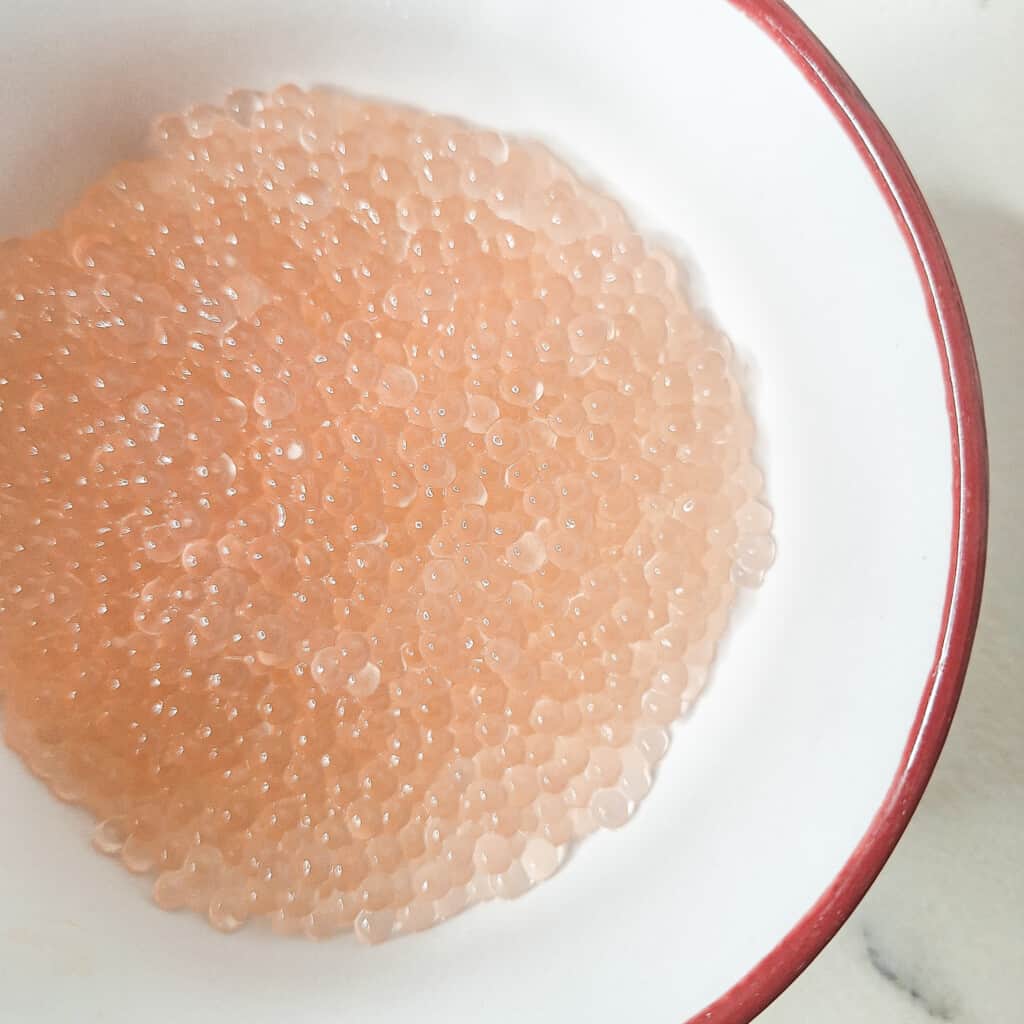
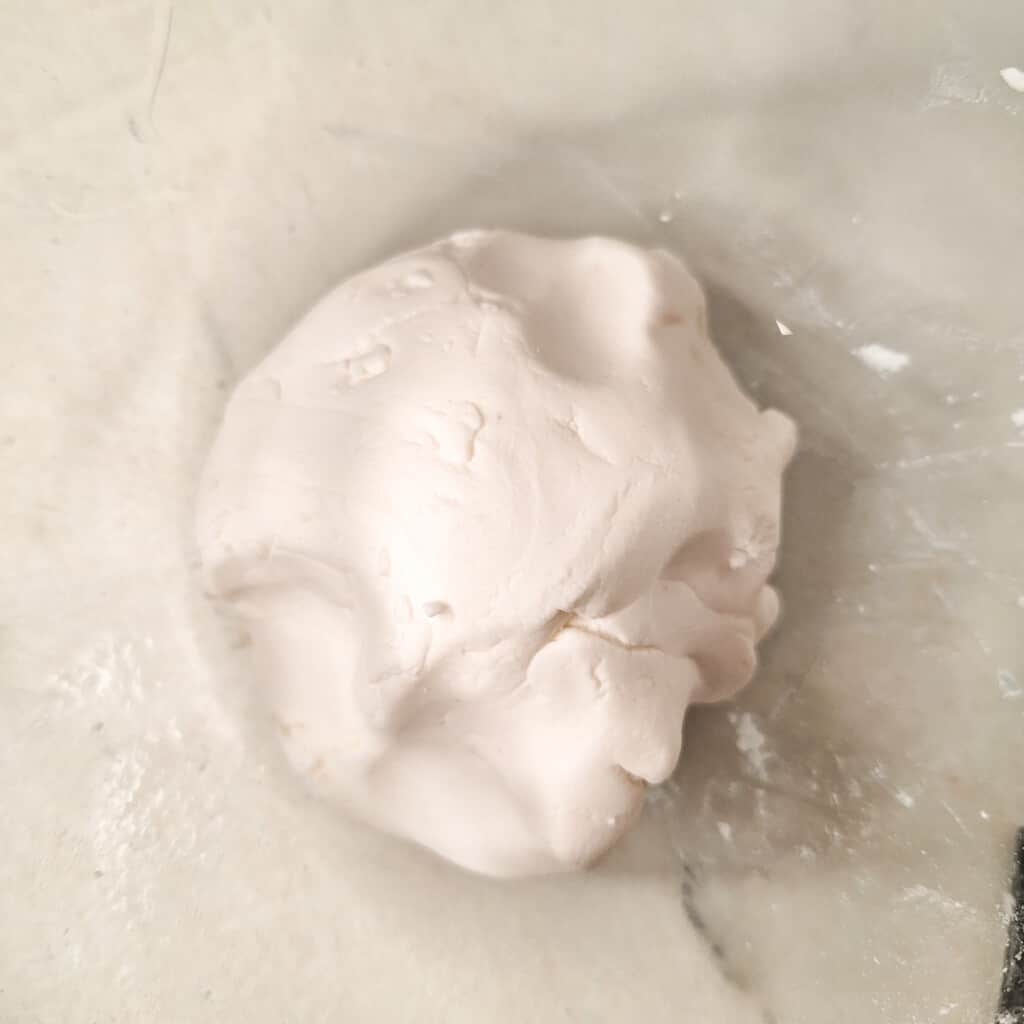

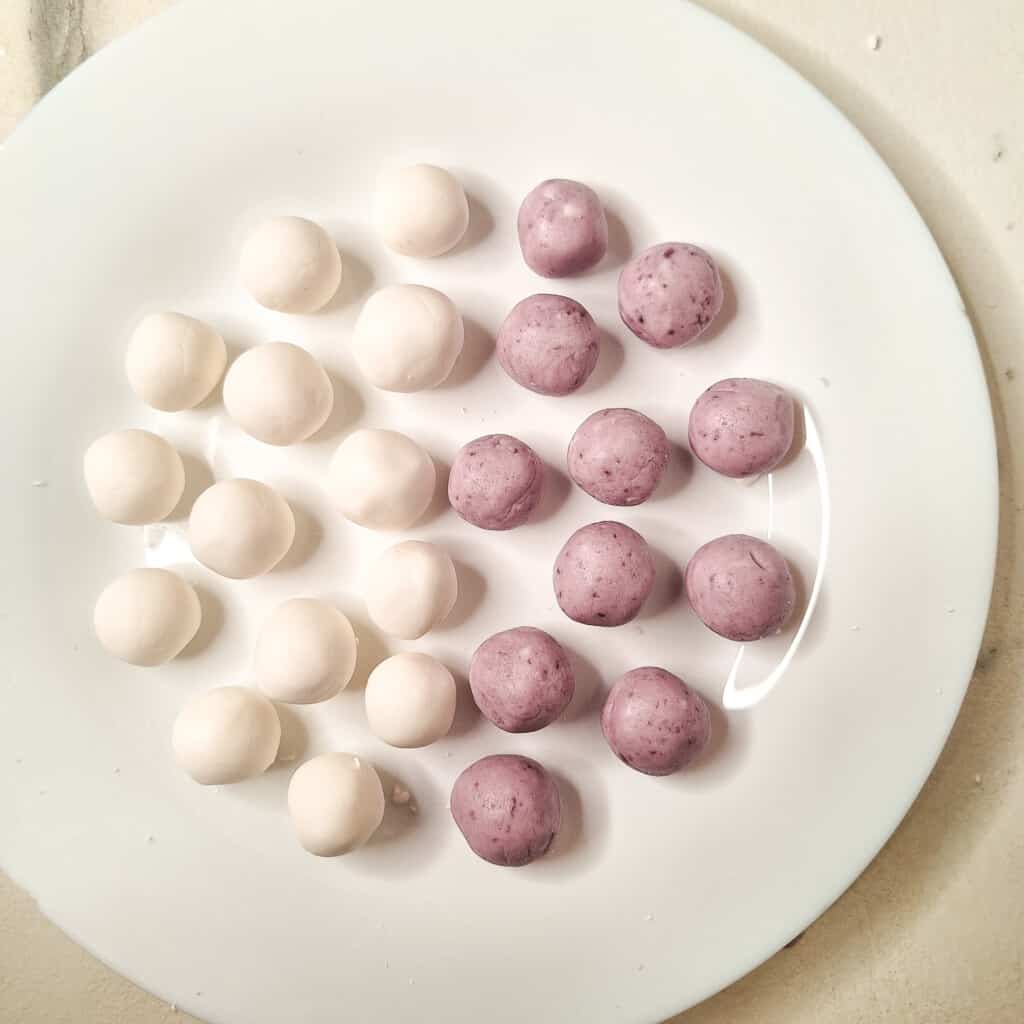



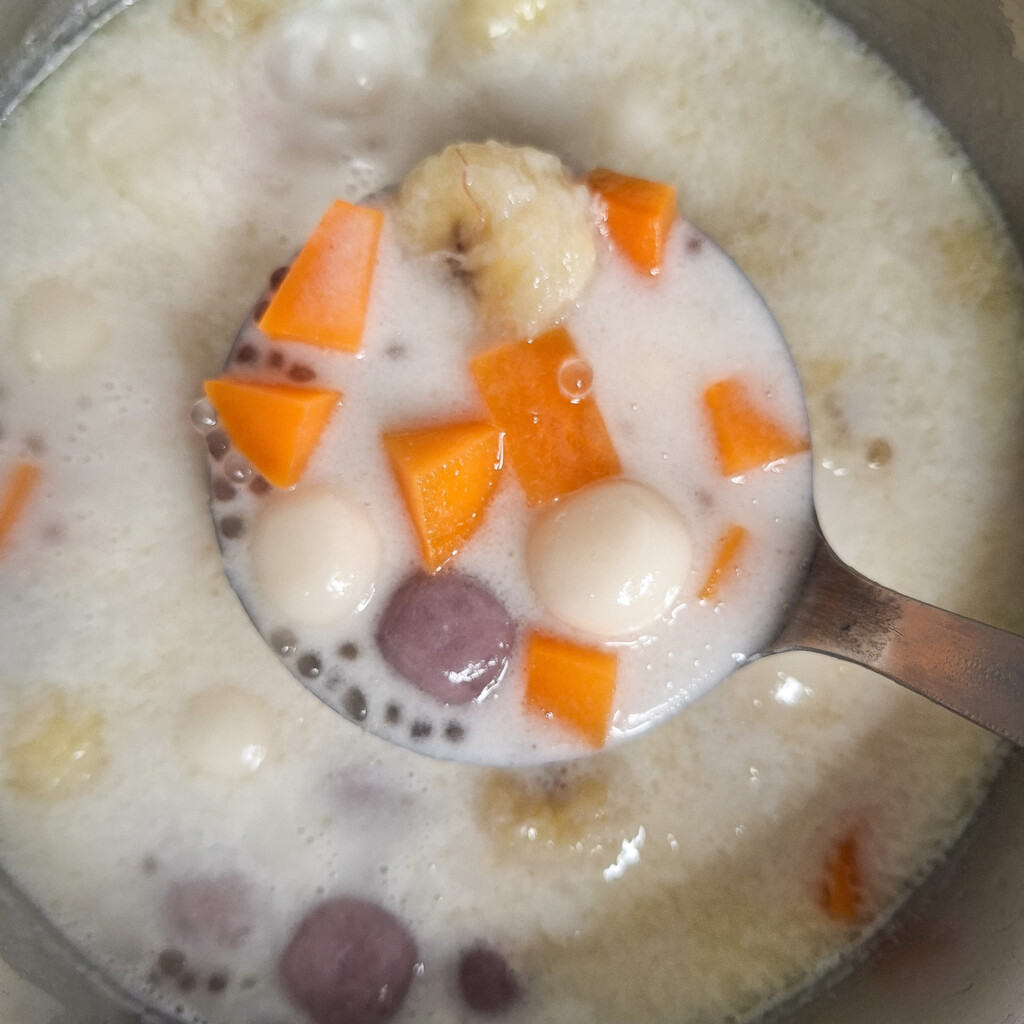
Here is a quick rundown of the recipe steps to give you an idea of the process:
- Cook tapioca pearls until they are translucent.
- Make the glutinous rice balls or bilo-bilo, then shape them.
- Cook the coconut soup.
This recipe is surprisingly simple in terms of prep for a dessert recipe! The most time-consuming thing would be shaping the sticky rice balls.
How to Serve Filipino Coconut Dessert Soup with Sago
You can serve this dessert soup right off the stove hot and fresh! One of the best traits of this dessert is that it gets better stored in the fridge overnight. It develops more flavors - the brightness from the bananas shines when you heat it the next day.
This soup is served best warm or room temperature. The sticky rice balls tend to harden at the center when cooled, but heating them again will make them chewy all over the same way when you first cooked them.
Variations
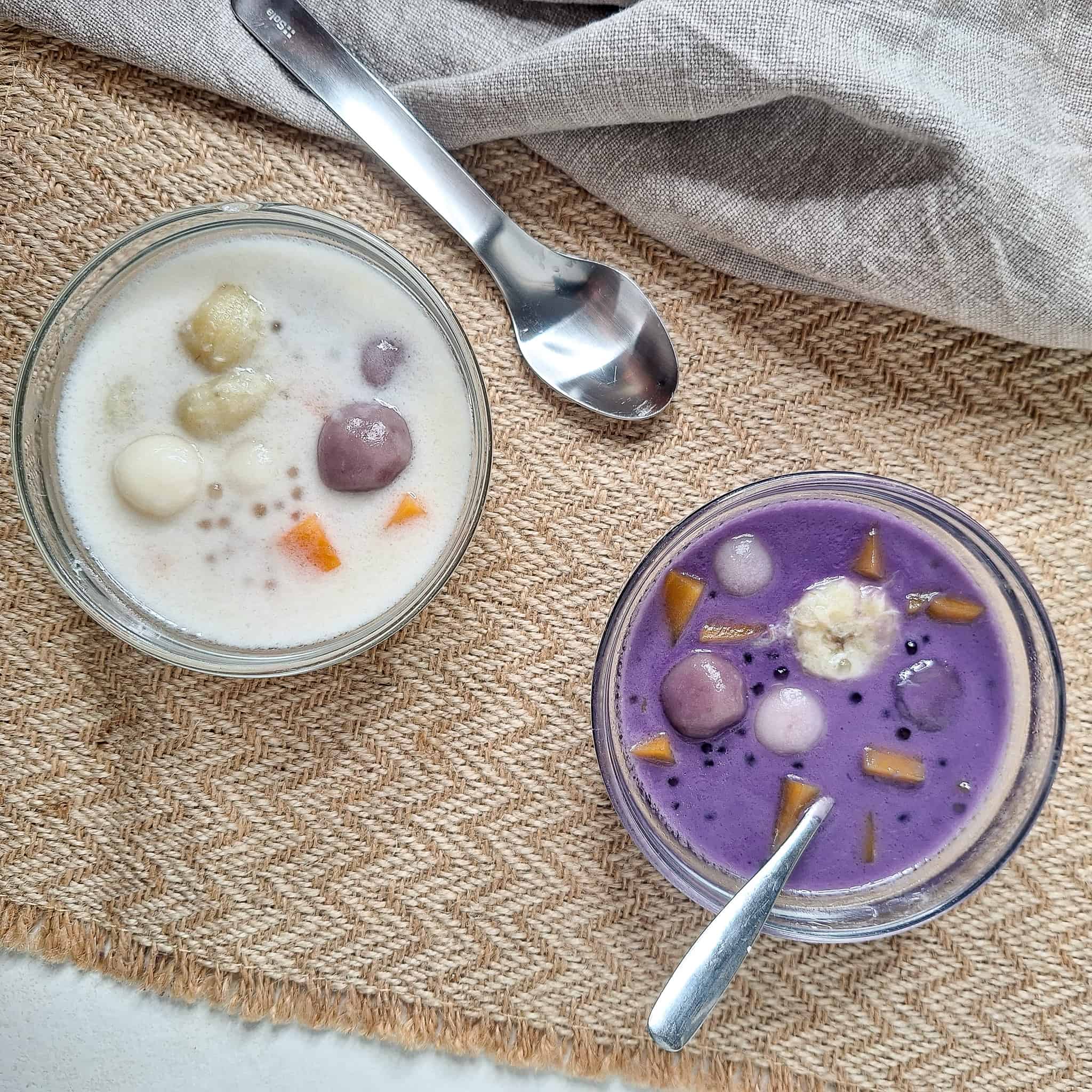
This ginataang bilo bilo takes on a variety of forms and additions. Depending on what is available around you will rely on what you can include in this recipe. Here are some suggestions on how to change things up:
- No Jackfruit, No Problem: I don't know if you noticed, but the images on this post currently do not show jackfruit. That's because it's nonexistent at grocery stores in this part of the world. I know I mentioned that jackfruit is optional in the recipe, but some people do make ginataang bilo bilo without them as their classic recipe.
- Add Ube Extract: Add a few drops of ube extract to your ginataan after cooking and gently stir to incorporate the extract. The coconut brings out the unique flavor of ube.
- Change the Tapioca Pearl Size: Some people enjoy making these with large tapioca pearls or none at all. It's all up to you!
Frequently Asked Questions
Ginataang means anything cooked in coconut milk, and bilo bilo is the name for the glutinous rice balls added to the coconut milk. The name of this dish literally translates to glutinous rice balls cooked in coconut milk.
You can keep ginataang bilo bilo for up to a week in an airtight container in the fridge. To reheat and eat, put about a cup and a half in a microwave-safe bowl and reheat in the microwave for one minute. You may need to reheat more if the center of the glutinous rice balls are still hard. In that case, reheat in twenty-second increments.
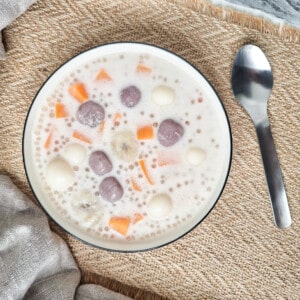
Filipino Coconut Dessert Soup with Sago - Ginataang Bilo Bilo
Disclosure
The equipment and ingredients sections contain affiliate links to products I love to use as well as items that I personally believe make this recipe the best version of itself.
Ingredients
Make Tapioca Balls
- 60 grams small tapioca balls
- 950 ml water
White Bilo Bilo (Glutinous Rice Balls)
- 115 grams glutinous rice flour
- 120 ml warm water may need to use more or less
Ube Bilo Bilo (Glutinous Rice Balls)
- 76 grams glutinous rice flour
- 4 tablespoon ube halaya (jam)
- 55 grams warm water may need to use more or less
Other
- 100 grams granulated white sugar
- 400 ml coconut milk 1 can
- 415 ml water
- 1 large banana sliced
- 1 medium sweet potato diced, medium
- 1 can yellow jackfruit, drained strips; optional
Instructions
Cook Sago (Tapioca) Balls
- Add 4 cups of the water to a small pot and bring to a boil. Add the tapioca balls.

- The water will stop boiling so bring it up to a boil again. Once boiling, lower to a simmer and cook for about 5 mins. After simmering for 5 mins, turn off the heat and let it sit in the hot water for 10 mins.

- Then strain out the hot water and rinse the tapioca balls in cold water to bring to room temperature. You may have to pour out the rinsing water and use more water. The balls will still have a white center.

- Add 4 more cups of water to the now empty pot. Bring to a boil again. Add the semi-cooked tapioca balls in the boiling water. Bring to a simmer and simmer for 5 mins again. Then turn off the heat and let it sit in the hot water for 10 mins. This time the balls should be 99% clear and fully cooked.
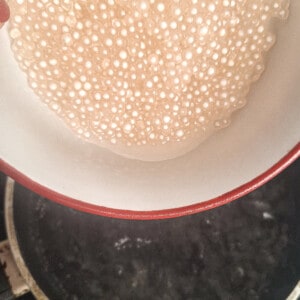
- Drain the hot water, then rinse again to bring the balls to room temperature. Pour the tapioca balls in a bowl with some room temp water to let sit while you make the glutinous rice balls.
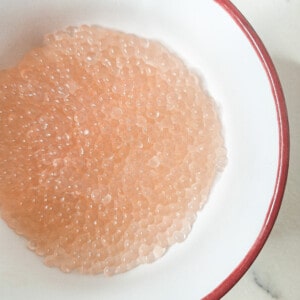
Make Bilo Bilo or Glutinous Rice Balls
- Plain Glutinous Balls: In a bowl, add the measured glutinous rice flour and half of the measured warm water. Stir with a spatula until the water has disappeared. Then add the rest of the warm water 1 tablespoon at a time as you continue to stir. You should get a shaggy dough. Keep mixing the water evenly into the dough until you get a smooth, malleable ball. Cover and let sit while you make the ube dough.
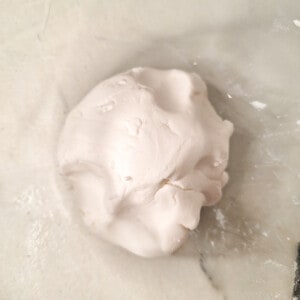
- Ube Glutinous Balls: Mix the measured glutinous rice flour, the ube halaya, and the half of the measured water. Add more water if you need to while you continue to mix and knead with a spoon. When the dough is shaggy and just comes together, you can start kneading with your hands until you get a smooth ball.
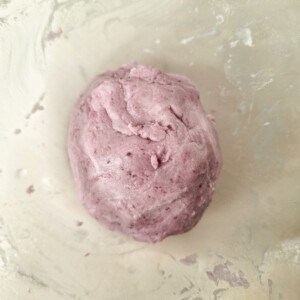
- Prepare a plate to place the formed glutinous rice balls. Then take a ½ teaspoon measuring spoon and scoop out some dough. Make a ball with the dough rolling it between the palm of your hands.

- Place the piece on the plate. Repeat for the rest of both dough until there is none left. Cover the plate with cling-wrap and set it aside.

Make the Ginataan or Coconut Soup Dessert
- In a heavy-bottomed pot, add the coconut milk, sugar, and 1.5 cups water for the ginataan. Set it on medium-low heat and bring to a simmer while stirring to melt the sugar. Add the diced sweet potato and let it cook as it simmers for 3 mins.
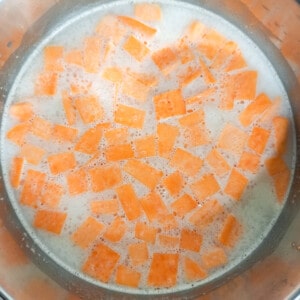
- Add the bananas and let them cook for 2 mins.

- Gently add the glutinous rice balls and bring to a simmer so that they cook. As the center of the glutinous rice balls get softer and cook thoroughly, they will float to the top. This will happen in about 3 to 5 mins while simmering.

- Once most of the glutinous rice balls float, drain the tapioca balls from its water, and add them to the pot. Gently mix everything together for another 2 minutes. Check that the sweet potatoes are soft enough but still have a bite.
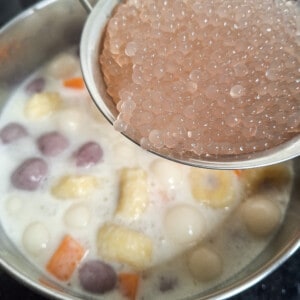
- Serve this dessert soup warm or room temperature.

Nutrition
Have You Tried This Recipe?
Simply rate the recipe by clicking on the ⭐️s on the recipe card. Have something to say? Please leave me a comment down below telling me what you think of this recipe.
Bonus: Let me and other readers know what you did to make this recipe your own - 💫 let's inspire each other!
Also, follow me on Instagram [@seesfoodwilltravel] and send me a DM with a picture of what you made. I would love to share and celebrate YOUR creation with our budding community 💞
Check out Sees Food, Will Travel on Pinterest and Facebook for more delicious updates.


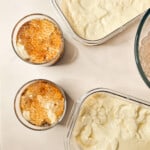

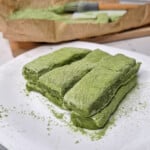

Leave a Reply